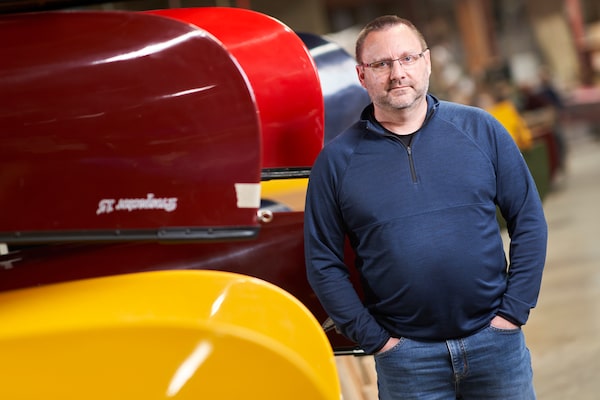
Chris Rath at Nova Craft Canoe’s facility in London, Ont., on April 27.Geoff Robins
Canadian canoe maker Nova Craft has seen a huge spike in demand, but export delays and supply chain challenges have hampered its ability to keep up.
The company, which has a retail outlet at its manufacturing facility in London, Ont., has benefited from pandemic-related restrictions that fuelled demand for outdoor recreation products.
“With the COVID restrictions, everybody was turning to the outdoors, so anything to do with camping and paddle sports, the demand has increased significantly,” says Nova Craft’s CEO Chris Rath, who purchased the company in 2019.
Since that time, Nova Craft – originally founded in 1970 – has increased exports from about 20 per cent of sales to more than 30 per cent. “It’s a significant part of our business,” Mr. Rath says, adding that the company sells its products to retail customers in Europe, Japan and New Zealand.

Mr. Rath talks with staff at the Nova Craft manufacturing facility.Geoff Robins
He credits the initial uptick in demand for Canadian-made canoes to former U.S. President Donald Trump, whose aluminum and steel tariffs caused the EU to respond with a 25-per-cent tax on U.S.-made canoes.
“We have a bit of an advantage as a Canadian supplier to avoid that tariff, which is significant,” Mr. Rath says.
However, the growth that should have resulted from a tariff advantage, coupled with the increased popularity of outdoor recreation during the pandemic, has been hindered by labour, shipping and supply chain challenges.
“The industry in North America has struggled to keep up with demand,” Mr. Rath says. “Our business has doubled, but I think if I could have scaled up more, our business would have been significantly more than just double.”
It’s not only the pandemic creating new challenges for Canadian manufacturers. From Canadian National Railway labour disputes to an unexpected snowstorm in Texas to the war in Ukraine, Mr. Rath says it feels like not a week goes by without an unanticipated disruption.
Like many Canadian small-business owners who rely on international markets, finding creative solutions to these challenges has become a primary function of Mr. Rath’s job. Anticipating future supply needs and ordering ahead, finding alternative materials to replace those that become scarce, and working with multiple suppliers instead of depending on just one are some of the ways he’s had to adapt. Despite such efforts, the business remains at the whims of a volatile global supply chain.

Employees at work at Nova Craft.Geoff Robins
For example, Mr. Rath says one of Nova Craft’s lower-end, plastic-made product lines is dependent on a foaming agent that’s only made in China. Anticipating some potential supply chain challenges Mr. Rath purchased a six-month reserve in October. However, the foaming agent recently ran out, and with much of China once again under lockdown, there’s no telling when the next shipment might arrive.
“Our plastics line has been shut down since about three weeks ago, with no indicators of when it might come back up,” Mr. Rath says. “We struggle every day with something that’s not available.”
That challenge is not uncommon among Canadian manufacturers tied to global markets, according to Fraser Johnson, a professor of operations management and director of the Purchasing Managers Index at the University of Western Ontario’s Ivey Business School.
“Supplier deliveries for the last 18 months or so have been at all-time lows in terms of speed,” Mr. Johnson says. “Prices have never been higher, and lead times have never been slower.”
According to Mr. Rath, the cost and wait times for sending a shipping container across the Atlantic Ocean have more than doubled since the start of the pandemic, which Mr. Johnson says is consistent with what he sees country-wide. It also doesn’t help that Mr. Rath’s products are big, heavy and mostly hollow.
“There isn’t anything on the consumer side that might be more challenging to ship internationally than a canoe,” Mr. Johnson says. “It’s just so much air.”
A single customer shipping small and infrequent loads across the ocean won’t be as much of a priority to overextended freight companies, Mr. Johnson explains, which is why he recommends companies share resources where possible.
“Work with your industry peers to band together because you’re going to get more attention if you have higher volumes and some consistency in terms of your shipping needs,” he says. “Getting the maximum capacity on a shipping container in terms of weight and volume is absolutely the right way to go.”
That strategy is one Mr. Rath has adopted. Nova Craft has partnered with other Canadian suppliers that ship to the same retail customers in Europe in recent months.
“We have towel suppliers, accessories like safety supplies and special covers for boats that are made by other Canadian manufacturers,” he says. “We consolidate them in our plant, and we load them underneath and in between canoes to make it palatable for the shipment; essentially, our accessories ship for free.”
Though it’s been a tumultuous couple of years, Mr. Rath is confident that the company can continue to find creative solutions to whatever global challenges come next.
“Certainly, it’s a lot of grinding and a lot of work to keep the wheels turning,” he says. “That’s just the challenge of manufacturing these days, but I think the outlook is pretty positive.”